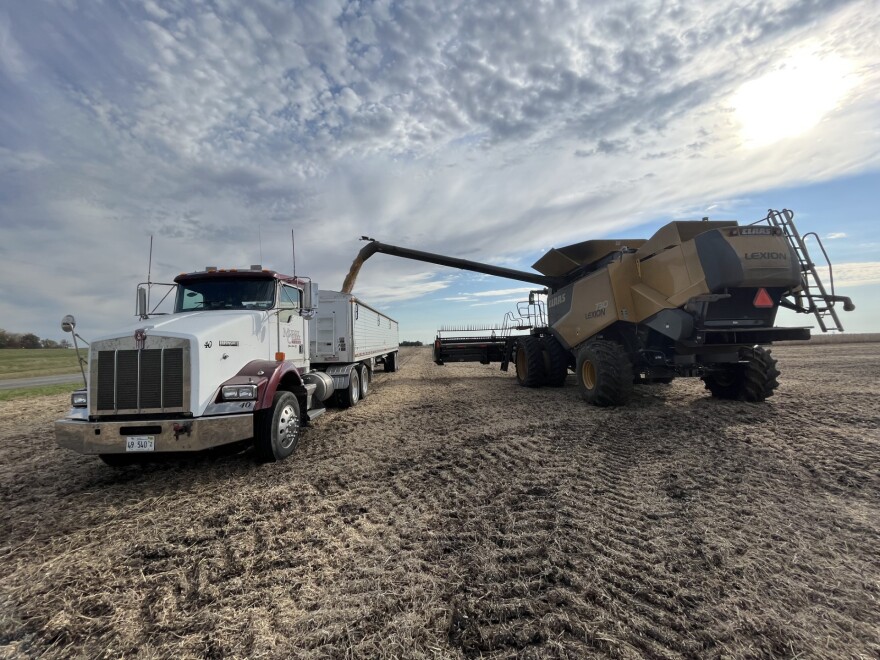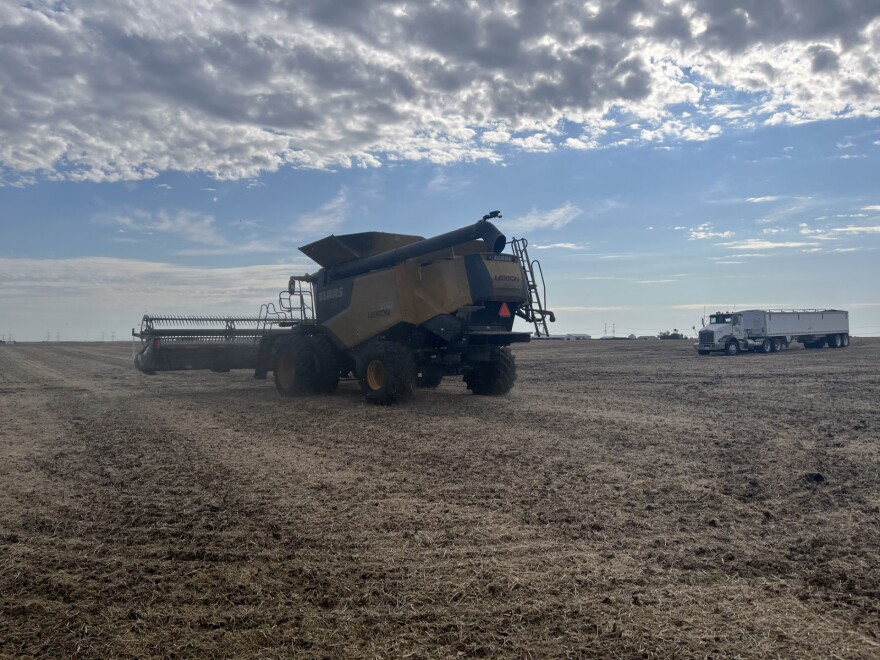If you've been traveling on rural roads recently, you may have found yourself behind a tractor hauling a bin full of corn or soybeans. Or maybe you've seen a cloud of dust moving through a field. These are tell-tale signs harvest season is underway.
I went back to Deer Creek farmer Dan Magarity's soybean fields to learn more about what central Illinois farmers put into harvest, from sun up to sun down.
Magarity's yellow Claas Lexion combine finishes a row of beans as I wait to take a seat in the cab. A tractor with a large storage bin and a semi wait nearby to take the harvested beans and haul them to the nearest elevator.
Magarity is on week six of harvest. It means 12 hour days. The lumbering combine uses around 140 gallons of gas a day, trundling along at 4 to 5 mph in corn and 2 to 3 mph in soybeans.
“They took the rain out of the forecast for the next two days, but Wednesday night they’re talking rain,” Magarity tells me as I climb into the cab. “We should finish the beans either late today or first thing tomorrow. Then we have 200 acres of corn left to harvest.”
How long harvest takes is entirely dependent on weather. As Magarity points out, he had to wait for the dew to dry off the soybeans before starting this morning. Too much moisture means beans go bad.
“The elevator, they don’t want beans above 15%,” he says. “They will dock you severely if you bring 15% beans.”

Fortunately, the technology to track moisture is in the cab. There's a lot of other information on screens inside the combine, too: satellite mapping tracks how much of Magarity's field he's harvested, while a red line over the map shows the path the machine will automatically follow when both hands aren't on the wheel.
“The tractor with the big Kinze wagon behind it that chases me, it also has guidance,” he says. “So we can be on the same line and it can be very, very dusty, but we know we won’t hit, because we’re guided on the same line.”
Magarity says none of this technology existed in the cab even 10 years ago. As he effortlessly finishes a row of beans and maneuvers the massive combine head in line with another one, he says it takes a lot of the stress out of operating a machine as large and powerful as a combine.
“Most experienced operators know their machine, they know what it can and can’t do,” Magarity says. “Up on my onboard computer, I can push it up to about 95% engine load and I know if I go much over that, I’m going to cause some problems.”

The readout on the screen remains over 90% for the majority of the morning. Magarity explains beans have a lot more plant matter and material to work through than corn.
There's a lot happening within the machine itself, depending on how you look at it four or five steps all happen in seconds within the combine.
“We have a sickle knife that travels just back and forth, left to right at 400 RPMs,” explains Magarity. “And the reel is gently pushing the beans back into what we call the belt. There’s two belts that run together to bring them into the center belt.”
Once on the center belt, the beans enter the "throat" of the combine and are thrown into the spinning pre-cylinder, where the process of shelling the beans starts. They slowly move into the primary cylinder, where shelling is finished and threshing removes the excess plant matter from the sellable soybeans.
Finally, twin rotors separate the beans from the pods.
Magarity tells me this field specifically is "seed beans."
“There was a seven-acre seed plot here,” he said. “So the seed beans, someone will buy these beans from Syngenta and they will grow them next year for their soybean crop.”

Magarity radios to the operator of the tractor and bin driving alongside the combine, letting him know that some processed beans are ready for unloading. The tractor slows a bit, and a beep in the cabin signals the auger arm has swung out off the side.
While still on the move, the combine begins filling the bed of the tractor bin with the shelled and threshed beans. A dull roar of beans leaving the combine joins the ambient hum of harvest. Another beep signals the arm has returned to the side of the machine.
“A good rule of thumb is always keep your unloading auger in,” says Magarity. “Trees and telephone poles do a lot of damage to an unloading auger. It happens to the best of us sometimes.”
Thousands of bushels of beans and corn head from Magarity's fields to elevators operated by the local co-op board. After a recent merger, Magarity says the board has 10 elevator locations throughout central Illinois.
“As of now, we’re over 50,000,000 bushels of corn and beans every year now,” he said. “And we currently have three train locations, where we can load trains.”
The sense of community goes beyond sharing elevators. Throughout the day, Magarity's radio buzzes with messages from neighboring farmers. They discuss the damp crops, combine brands and the coyotes seen in their fields.
While harvest can be hard work, it's also a time for tradition. Magarity says his wife or his son's wife brings them lunch, which they may take on-the-go.
“It’s just always been this way, it came from my wife’s mom and further up the line,” he says. “At five o’ clock or so they will bring out a full meal. We stop, we take a break and we have supper. That’s just something we’ve always done.”
For central Illinois farmers, harvest means effort from themselves, their family and their community.


